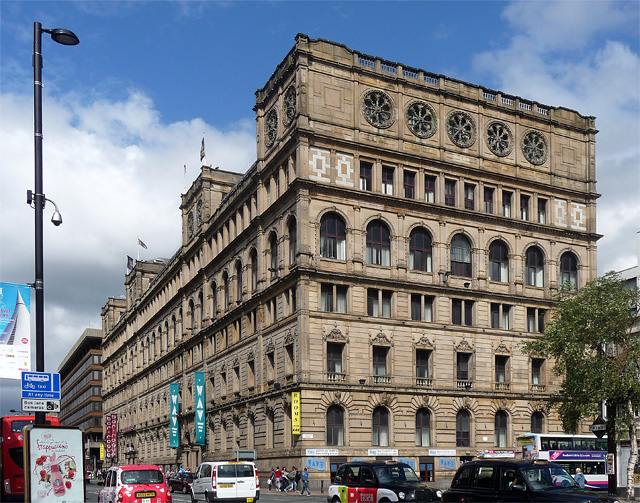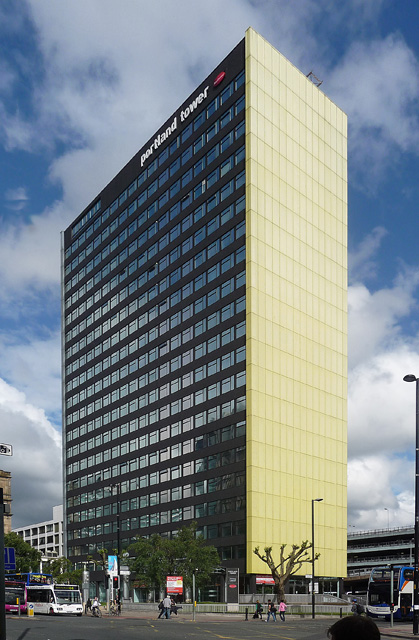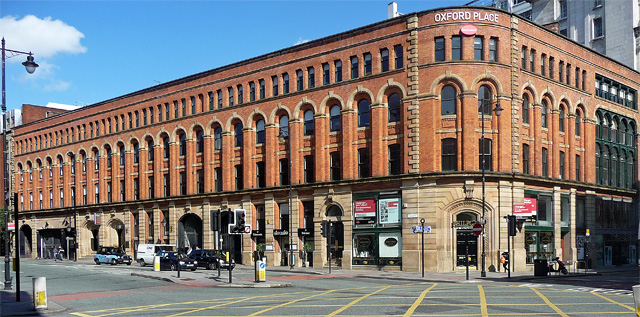Portland Street, Manchester on:
[Wikipedia]
[Google]
[Amazon]


 Portland Street is a street in
Portland Street is a street in
 One building is grade II* listed (Watts Warehouse) and many are grade II listed, including the former Pickles Building at no. 101, the Portland Thistle Hotel at 3, 5 and 9, Nos. 74–80 (including the Grey Horse public house) and many old Victorian textile warehouses.
*Watts Warehouse (1851), now Britannia House, at Nos. 35–47 between Minshull Street and Chorlton Street. The architects were Travis & Mangnall and each floor is built in a different architectural style, none of which are Gothic or Classical but "a licentious bit of confectionery in stone, iron, timber and glass".Sharp, Dennis, ed. (1969) ''Manchester''. (City Buildings Series.) London: Studio Vista; pp. 20–21 At the top are four roof pavilions with wheel windows. It was converted to a variety of new uses in the mid-1970s.
*St Andrew's House (1962), between Chorlton Street and Sackville Street, architects Leach, Rhodes & Walker, and Telephone House (1961), between Sackville Street and Abingdon Street, are tall slabs set back from the original building line. St Andrew's House was built by a technique which was new at the time: the core of the 21-storey building was cast continuously using a climbing shutter and the precast external panels fixed using a tower crane thus dispensing with scaffolding. Thus tenants were installed on the lowest floors before the upper seven storeys had been built.
* Bank of England building (1971), between York Street and Charlotte Street, architects
One building is grade II* listed (Watts Warehouse) and many are grade II listed, including the former Pickles Building at no. 101, the Portland Thistle Hotel at 3, 5 and 9, Nos. 74–80 (including the Grey Horse public house) and many old Victorian textile warehouses.
*Watts Warehouse (1851), now Britannia House, at Nos. 35–47 between Minshull Street and Chorlton Street. The architects were Travis & Mangnall and each floor is built in a different architectural style, none of which are Gothic or Classical but "a licentious bit of confectionery in stone, iron, timber and glass".Sharp, Dennis, ed. (1969) ''Manchester''. (City Buildings Series.) London: Studio Vista; pp. 20–21 At the top are four roof pavilions with wheel windows. It was converted to a variety of new uses in the mid-1970s.
*St Andrew's House (1962), between Chorlton Street and Sackville Street, architects Leach, Rhodes & Walker, and Telephone House (1961), between Sackville Street and Abingdon Street, are tall slabs set back from the original building line. St Andrew's House was built by a technique which was new at the time: the core of the 21-storey building was cast continuously using a climbing shutter and the precast external panels fixed using a tower crane thus dispensing with scaffolding. Thus tenants were installed on the lowest floors before the upper seven storeys had been built.
* Bank of England building (1971), between York Street and Charlotte Street, architects


 Portland Street is a street in
Portland Street is a street in Manchester
Manchester () is a city in Greater Manchester, England. It had a population of 552,000 in 2021. It is bordered by the Cheshire Plain to the south, the Pennines to the north and east, and the neighbouring city of Salford to the west. The ...
, England, which runs from Piccadilly
Piccadilly () is a road in the City of Westminster, London, to the south of Mayfair, between Hyde Park Corner in the west and Piccadilly Circus in the east. It is part of the A4 road that connects central London to Hammersmith, Earl's Cour ...
at its junction with Newton Street south-westwards to Oxford Street
Oxford Street is a major road in the City of Westminster in the West End of London, running from Tottenham Court Road to Marble Arch via Oxford Circus. It is Europe's busiest shopping street, with around half a million daily visitors, and ...
at its junction with Chepstow Street. The major buildings of Portland Street include the largest former warehouse
A warehouse is a building for storing goods. Warehouses are used by manufacturers, importers, exporters, wholesalers, transport businesses, customs, etc. They are usually large plain buildings in industrial parks on the outskirts of citie ...
in the city centre, Watts Warehouse
Watts Warehouse is a large, ornate Victorian Grade II* listed building standing on Portland Street in the centre of Manchester, England. It opened in 1856 as a textile warehouse for the wholesale drapery business of S & J Watts, and was the la ...
(grade II* listed), the former Bank of England
The Bank of England is the central bank of the United Kingdom and the model on which most modern central banks have been based. Established in 1694 to act as the English Government's banker, and still one of the bankers for the Government o ...
Building and other former warehouses on the corners of Princess Street.
Location
Portland Street was a name given to a new street on the site of a lane called Garrett Lane after a 14th-century hall, Garrett Hall; like some others, it was borrowed from the street of the same name in London by wealthy Manchester men in the early 19th century. It became Victorian Manchester's showpiece: until the 1850s, it ended at David Street (afterwards renamed Princess Street). From the 1840s, this part of the town began to be taken over bywarehouses
A warehouse is a building for storing goods. Warehouses are used by manufacturers, importers, exporters, wholesalers, transport businesses, customs, etc. They are usually large plain buildings in industrial parks on the outskirts of cities, town ...
and during the 1850s and 1860s they predominated in Portland Street.
The 1911 Victoria County History
The Victoria History of the Counties of England, commonly known as the Victoria County History or the VCH, is an English history project which began in 1899 with the aim of creating an encyclopaedic history of each of the historic counties of E ...
refers to "a very fine vista of unbroken line" of warehouse buildings "chiefly constructed in brick and terra cotta". Its parade of impressive buildings was reduced by bombing during the Manchester Blitz
The Manchester Blitz (also known as the Christmas Blitz) was the heavy bombing of the city of Manchester and its surrounding areas in North West England during the Second World War by the German '' Luftwaffe''. It was one of three major raids ...
of the Second World War
World War II or the Second World War, often abbreviated as WWII or WW2, was a world war that lasted from 1939 to 1945. It involved the vast majority of the world's countries—including all of the great powers—forming two opposi ...
and some later development ignored the old building line.
Buildings
 One building is grade II* listed (Watts Warehouse) and many are grade II listed, including the former Pickles Building at no. 101, the Portland Thistle Hotel at 3, 5 and 9, Nos. 74–80 (including the Grey Horse public house) and many old Victorian textile warehouses.
*Watts Warehouse (1851), now Britannia House, at Nos. 35–47 between Minshull Street and Chorlton Street. The architects were Travis & Mangnall and each floor is built in a different architectural style, none of which are Gothic or Classical but "a licentious bit of confectionery in stone, iron, timber and glass".Sharp, Dennis, ed. (1969) ''Manchester''. (City Buildings Series.) London: Studio Vista; pp. 20–21 At the top are four roof pavilions with wheel windows. It was converted to a variety of new uses in the mid-1970s.
*St Andrew's House (1962), between Chorlton Street and Sackville Street, architects Leach, Rhodes & Walker, and Telephone House (1961), between Sackville Street and Abingdon Street, are tall slabs set back from the original building line. St Andrew's House was built by a technique which was new at the time: the core of the 21-storey building was cast continuously using a climbing shutter and the precast external panels fixed using a tower crane thus dispensing with scaffolding. Thus tenants were installed on the lowest floors before the upper seven storeys had been built.
* Bank of England building (1971), between York Street and Charlotte Street, architects
One building is grade II* listed (Watts Warehouse) and many are grade II listed, including the former Pickles Building at no. 101, the Portland Thistle Hotel at 3, 5 and 9, Nos. 74–80 (including the Grey Horse public house) and many old Victorian textile warehouses.
*Watts Warehouse (1851), now Britannia House, at Nos. 35–47 between Minshull Street and Chorlton Street. The architects were Travis & Mangnall and each floor is built in a different architectural style, none of which are Gothic or Classical but "a licentious bit of confectionery in stone, iron, timber and glass".Sharp, Dennis, ed. (1969) ''Manchester''. (City Buildings Series.) London: Studio Vista; pp. 20–21 At the top are four roof pavilions with wheel windows. It was converted to a variety of new uses in the mid-1970s.
*St Andrew's House (1962), between Chorlton Street and Sackville Street, architects Leach, Rhodes & Walker, and Telephone House (1961), between Sackville Street and Abingdon Street, are tall slabs set back from the original building line. St Andrew's House was built by a technique which was new at the time: the core of the 21-storey building was cast continuously using a climbing shutter and the precast external panels fixed using a tower crane thus dispensing with scaffolding. Thus tenants were installed on the lowest floors before the upper seven storeys had been built.
* Bank of England building (1971), between York Street and Charlotte Street, architects Fitzroy Robinson & Partners
Fitzroy Robinson & Partners was one of the UK's largest firms of architects. It was based at Devonshire Street in London.
History
The firm was established by Herbert Fitzroy Robinson in 1956. Public buildings designed by the firm included 102 Pet ...
, consists of a solid podium topped by two contrasting blocks. Having been vacated by the bank it has been converted to other uses.
*Pickles Building (1870) on the east side, at no. 101 on Princess Street corner, is a former warehouse; the architects were Clegg & Knowles.Stewart, Cecil (1956) ''The Stones of Manchester''. London: Edward Arnold; pp. 101–03
* Westminster House (1970s), was built as the County Hall (head office) for Greater Manchester County Council, an administrative body covering the region from 1974 to 1986.
* The Circus Tavern claims to have the smallest bar in Europe. It is a Grade II listed building.
Transport
The northernmost section of Portland Street is close to the bus and Metrolink stations atPiccadilly Gardens
Piccadilly Gardens is a green space in Manchester city centre, England, on the edge of the Northern Quarter.
It takes its name from the adjacent street, Piccadilly, which runs across the city centre from Market Street to London Road. The g ...
and the Metrolink line towards Piccadilly railway station crosses Portland Street to get into Aytoun Street. There are bus stops for southbound services near Sackville Street and northbound services near Dickinson Street. Chorlton Street coach station is nearby south of Chorlton Street next to the gay village
A gay village is a geographical area with generally recognized boundaries that is inhabited or frequented by many lesbian, gay, bisexuality, bisexual, transgender, and queer (LGBT) people. Gay villages often contain a number of gay-orien ...
.
See also
* List of streets and roads in ManchesterReferences
Further reading
*Hartwell, Clare (2001) ''Manchester''. (Pevsner Architectural Guides.) London: Penguin ; p. 191–194 {{Commons category, Portland Street, Manchester Streets in Manchester